September 27, 1998Kofi Annan's Astonishing Facts!By BARBARA CROSSETTE very
year, the United Nations Human Development Report looks for a new way to
measure the lives of people. Putting aside faceless statistics like per
capita gross domestic product or export-import figures, the report burrows
into the facts about what children eat, who goes to school, whether there
is clean water to drink, how women share in the economy or who doesn't
get vaccinations against diseases that go on killing even though they are
preventable. This year, the report takes its first look at what people
have -- from simple toilets to family cars -- and what proportion of the
world's goods and services are consumed, comparatively, by the rich and
by the poor. The pie is huge -- the world's consumption bill is $24 trillion
a year -- but some servings are very small indeed. very
year, the United Nations Human Development Report looks for a new way to
measure the lives of people. Putting aside faceless statistics like per
capita gross domestic product or export-import figures, the report burrows
into the facts about what children eat, who goes to school, whether there
is clean water to drink, how women share in the economy or who doesn't
get vaccinations against diseases that go on killing even though they are
preventable. This year, the report takes its first look at what people
have -- from simple toilets to family cars -- and what proportion of the
world's goods and services are consumed, comparatively, by the rich and
by the poor. The pie is huge -- the world's consumption bill is $24 trillion
a year -- but some servings are very small indeed.
NATURAL RESOURCES Since 1970, the world's forests have declined from 4.4 square miles per 1,000 people to 2.8 square miles per 1,000 people. In addition, a quarter of the world's fish stocks have been depleted or are in danger of being depleted and another 44 percent are being fished at their biological limit.
THE ULTRA RICH The three richest people in the world have assets that exceed the combined gross domestic product of the 48 least developed countries. AFRICA The average African household today consumes 20 percent less than it did 25 years ago. THE SUPER RICH The world's 225 richest individuals, of whom 60 are Americans with total assets of $311 billion, have a combined wealth of over $1 trillion -- equal to the annual income of the poorest 47 percent of the entire world's population.
THE HAVE NOTS Of the 4.4 billion people in developing countries, nearly three-fifths lack access to safe sewers, a third have no access to clean water, a quarter do not have adequate housing and a fifth have no access to modern health services of any kind.
THE FUTURE By 2050, 8 billion of the world's
projected 9.5 billion people -- up from about 6 billion today -- will be
living in developing countries.
million are from indoor pollution -- including smoke from dung and wood burned as fuel which is more harmful than tobacco smoke. 80 percent of the victims are rural poor in developing countries.
TELEPHONE LINES Sweden and the United States have 681 and 626 telephone lines per 1,000 people, respectively. Afghanistan, Cambodia, Chad and the Democratic Republic of the Congo have only one line per 1,000 people. ICE CREAM AND WATER Europeans spend $11 billion a year on ice cream -- $2 billion more than the estimated annual total needed to provide clean water and safe sewers for the world's population. AIDS At the end of 1997 nearly 31 million people were living with HIV, up from 22.3 million the year before. With 16,000 new infections a day -- 90 percent in developing countries -- it is now estimated that 40 million people will be living with HIV in 2000.
PET FOOD AND HEALTH Americans and Europeans spend $17 billion a year on pet food -- $4 billion more than the estimated annual additional total needed to provide basic health and nutrition for everyone in the world.
Photographs: Hot dog eaters, Amy Toensing for The New York Times; Bathers in the Ganges, Reuters; Pollution in the Ganges, Associated Press; Poor family in Haiti, Associated Press; Hereford cow, Jim Estrin/The New York Times; Man washing bicycle near Taj Mahal, Agence France-Presse; Mine victim/amputee, Associated Press; Starving child, Agence France-Presse. |
 THE
HAVES The richest fifth of the world's people consumes 86 percent of all
goods and services while the poorest fifth consumes just 1.3 percent. Indeed,
the richest fifth consumes 45 percent of all meat and fish, 58 percent
of all energy used and 84 percent of all paper, has 74 percent of all telephone
lines and owns 87 percent of all vehicles.
THE
HAVES The richest fifth of the world's people consumes 86 percent of all
goods and services while the poorest fifth consumes just 1.3 percent. Indeed,
the richest fifth consumes 45 percent of all meat and fish, 58 percent
of all energy used and 84 percent of all paper, has 74 percent of all telephone
lines and owns 87 percent of all vehicles.
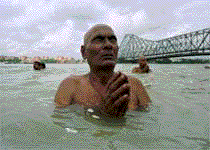 THE
GANGES The Ganges River symbolizes purification to Hindus, who believe
drinking or bathing in its waters will lead to salvation. But 29 cities,
70 towns and countless villages deposit about 345 million gallons of raw
sewage a day directly into the river. Factories add 70 million gallons
of industrial waste and farmers are responsible for another 6 million tons
of chemical fertilizer and 9,000 tons of pesticides.
THE
GANGES The Ganges River symbolizes purification to Hindus, who believe
drinking or bathing in its waters will lead to salvation. But 29 cities,
70 towns and countless villages deposit about 345 million gallons of raw
sewage a day directly into the river. Factories add 70 million gallons
of industrial waste and farmers are responsible for another 6 million tons
of chemical fertilizer and 9,000 tons of pesticides.
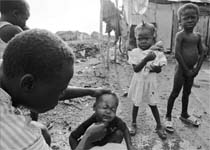 COSMETICS
AND EDUCATION Americans spend $8 billion a year on cosmetics -- $2 billion
more than the estimated annual total needed to provide basic education
for everyone in the world.
COSMETICS
AND EDUCATION Americans spend $8 billion a year on cosmetics -- $2 billion
more than the estimated annual total needed to provide basic education
for everyone in the world.
 MEAT
Americans each consume an average of 260 pounds of meat a year. In Bangladesh,
the average is six and a half pounds.
MEAT
Americans each consume an average of 260 pounds of meat a year. In Bangladesh,
the average is six and a half pounds.
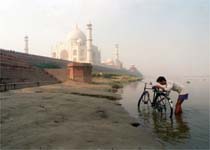 WRISTWATCHES
AND RADIOS Two thirds of India's 90 million lowest-income households live
below the poverty line -- but more than 50 percent of these impoverished
people own wristwatches, 41 percent own bicycles, 31 percent own radios
and 13 percent own fans.
WRISTWATCHES
AND RADIOS Two thirds of India's 90 million lowest-income households live
below the poverty line -- but more than 50 percent of these impoverished
people own wristwatches, 41 percent own bicycles, 31 percent own radios
and 13 percent own fans.
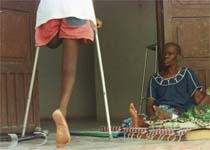
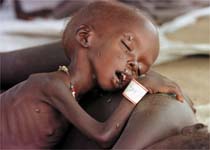 $40
BILLION A YEAR It is estimated that the additional cost of achieving and
maintaining universal access to basic education for all, basic health care
for all, reproductive health care for all women, adequate food for all
and clean water and safe sewers for all is roughly $40 billion a year --
or less than 4 percent of the combined wealth of the 225 richest people
in the world.
$40
BILLION A YEAR It is estimated that the additional cost of achieving and
maintaining universal access to basic education for all, basic health care
for all, reproductive health care for all women, adequate food for all
and clean water and safe sewers for all is roughly $40 billion a year --
or less than 4 percent of the combined wealth of the 225 richest people
in the world.